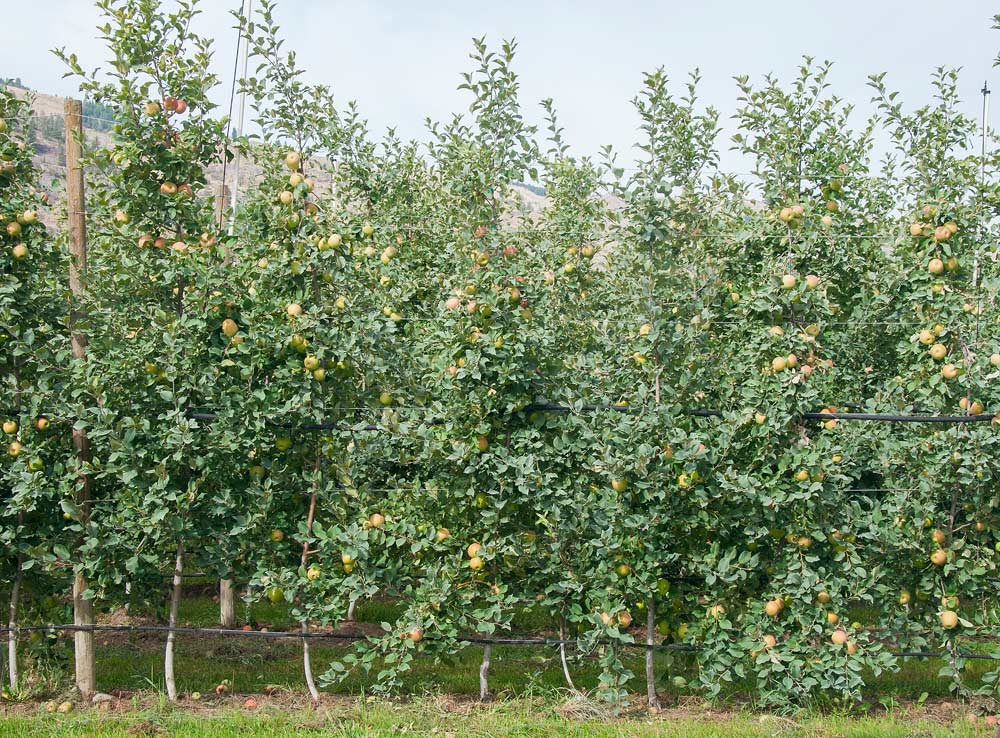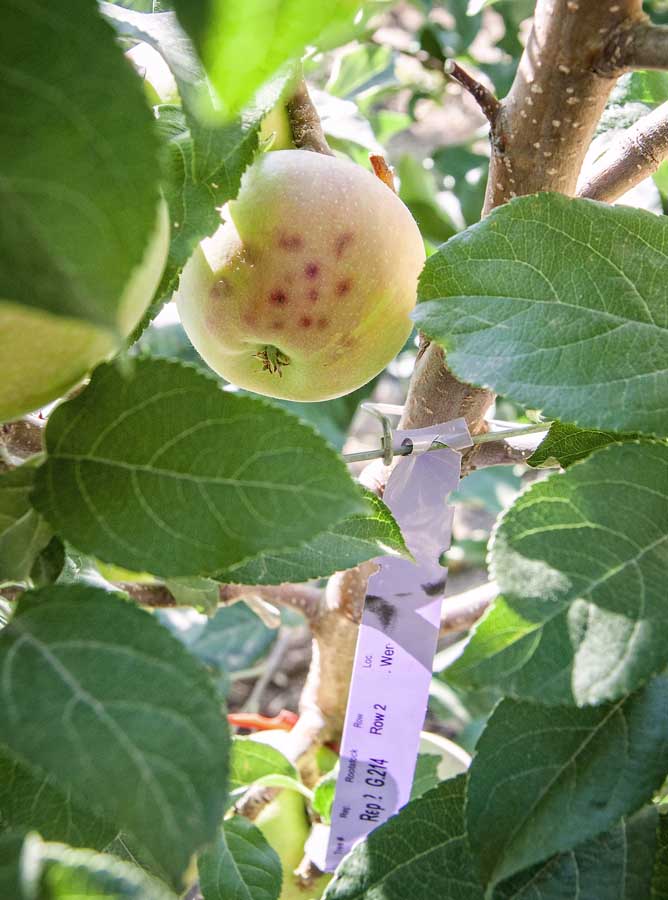
Now in their third lead, Honeycrisp trees in planted on a variety of Geneva rootstocks have all reached the top wire and show strong cropping. These trees in Oroville, Washington, are part of at Washington Tree Fruit Research Commission trial to evaluate performance in different orchard systems.(Kate Prengaman/Good Fruit Grower)
In northern Washington, the rows of a Geneva rootstock trial are easy to spot.
In a third leaf Pazazz block near Brewster, the trees planted on Geneva rootstocks tower above their neighbors planted on industry mainstay Budagovsky 9. The scene repeats at a Honeycrisp block in East Wenatchee, where a few rows planted on Genevas — renowned for their high precocity — stand out starkly against adjacent rows planted on Malling 9 T337 that are still well shy of the top wire in the third leaf.
“Every one of these Genevas, even where we cropped them, are doing better than the 337s we deflowered,” said Scott McDougall, co-president of McDougall and Sons, which planted Honeycrisp trees for the trial in partnership with the Washington Tree Fruit Research Commission. “Now, we need to start paying the bills and these (trees planted on T337) are going to need another year of thinning to get them to the top.”
That stark comparison shows why, despite wariness following the unexpected and unexplained collapse of some varieties on Geneva 935 rootstocks last year, many growers remain eager to plant on the rootstocks. In addition to its precocious nature, the Geneva series offers tolerance to replant disease and fire blight, and some selections resist woolly apple aphids as well, making them ideal for organic growers.

Researchers look at bitter pit development as one factor in evaluating the performance of Geneva rootstocks in the third year of the Washington Tree Fruit Research Commission trial. The disorder is seen here on Honeycrisp on Geneva 214 during the August 2017 tour of the trial in East Wenatchee. (Kate Prengaman/Good Fruit Grower)
As the industry learns more about the rootstocks developed by the U.S. Department of Agriculture and Cornell University, it’s increasingly apparent that there is not going to be one recommended rootstock.
“None I’m willing to say are the best, but they are all better than M.9,” said horticulturist Tom Auvil, who led a tour of the rootstock trials planted in three northern Washington orchards in late August. “As we gain experience with these rootstocks, we’ll look at planting density, soils and scion and better match all those factors. We’ll have that figured out in 10 or 20 years.”
In the meantime, growers will have to make do with anecdotal information from trials like this one and availability from nurseries. In 2017, the first bearing year for the Washington trial, Auvil said that G.41, G.214 and G.969 appear to be winning in the crop load capacity.
In his Honeycrisp orchard, McDougall said that G.969 looked particularly encouraging from a cropping standpoint because the fruit size is smaller and cropping in the third leaf regulated the trees’ growth well. Lauded in the Northeastern U.S. as a rootstock for a free-standing tree, it’s only recently been tested in the Northwest in trellised systems. Auvil said it’s one of the easiest for nurseries to produce and it could be a good replacement for the larger M.9. Nic 29.
Among the other insights Auvil offered to growers on the tour:
—G.890 is a vigorous, semi-dwarfing rootstock that would be an excellent choice for replacement trees in an already-bearing orchard. “It will scavenge for water and fertilizer more than the dwarf rootstocks, and it’s precocious enough that if you don’t aggravate it with pruning it will get a good crop,” Auvil said. It’s a tough rootstock that will also do well on difficult sites, and cropping the tree early helps to control the vigor, he added.
—G.41 appears to be the most reliable for a wide variety of scions and soil types and offers the best size control, although there have been concerns about weak graft unions with some varieties. Growers can mitigate by buying smaller caliper trees and handling them carefully. G.41 also favors annual bearing more strongly than some of its siblings, Auvil said.
—G.210 seems to increase fruit size and bitter pit incidence in one of the Honeycrisp orchards in the trial, Auvil said, as does G.41. But there’s not a strong link between fruit size and rootstock across the trial, he added. Overall, G.210 is a more vigorous tree that may be a good choice in replant situations.
—G.11 lacks wooly apple aphid resistance, but it’s a good M.9 replacement on most sites unless the soil is very sandy, Auvil said.
Although G.935 incompatibility has been a disaster for some growers with red strains of Honeycrisp and Pazazz, it’s also performing very well in most cases, Auvil said. It’s little consolation to the growers who lost lots of trees, but in a way, it’s fortunate that problems surfaced so early, he said.
“The collapse in the first or second leaf is more convenient than a slow, miserable decline after it reaches the top of the wire. Being worthless by the sixth leaf is a worst-case scenario,” he said.
The leading theory is that an as-yet-unidentified virus or combination of viruses causes the symptoms, which leads Auvil to conclude that G.935 should be safe and productive for planting with Cosmic Crisp, which is all certified virus free. Others remain more cautious on that front since the cause of the collapse has not yet been ascertained, including research commission director Mike Willett and Northwest Nursery Improvement Institute manager Bill Howell.

A row of Pazazz trees on Geneva rootstocks tower over the rest of the block, planted on Bud 9 rootstocks. The trees are now in their third leaf and provide insight into the performance of the new rootstocks during an August 2017 tour of the Washington Tree Fruit Research Commission rootstock trial orchards in Brewster. (Kate Prengaman/Good Fruit Grower)
Every orchard in the trial is managed differently, which means that it’s hard to link any one performance attribute directly to the rootstock. Across this trial, there are different training systems, replant sites and new ground, and different levels of cropping in the early years of growth.
“Horticultural practices create more variability than what the rootstocks provide,” Auvil said, but it’s important to see how the rootstocks perform across different practices. “When we see nice canopies full of fruit, and we see it here and there and there, we know it’s probably a rootstock effect.” •
by Kate Prengaman






Leave A Comment